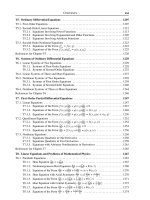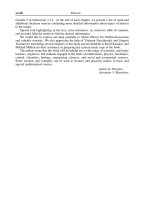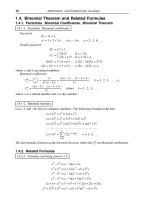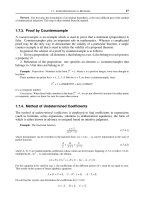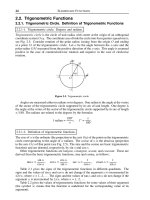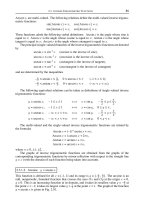Handbook of mathematics for engineers and scienteists part 7 docx
Bạn đang xem bản rút gọn của tài liệu. Xem và tải ngay bản đầy đủ của tài liệu tại đây (384.6 KB, 7 trang )
10 ARITHMETIC AND ELEMENTARY ALGEBRA
1.4. Binomial Theorem and Related Formulas
1.4.1. Factorials. Binomial Coefficients. Binomial Theorem
1.4.1-1. Factorials. Binomial coefficients.
Factorial:
0!=1!=1,
n!=1×2×3× × (n – 1)n, n = 2, 3, 4,
Double factorial:
0!! = 1!! = 1,
n!! =
(2k)!! if n = 2k,
(2k + 1)!! if n = 2k + 1,
(2k)!! = 2×4×6× × (2k – 2)(2k)=2
k
k!,
(2k + 1)!! = 1×3×5× × (2k – 1)(2k + 1),
where n and k are natural numbers.
Binomial coefficients:
C
k
n
=
n
k
=
n!
k!(n – k)!
=
n(n – 1) (n – k + 1)
k!
, k = 1, 2, 3, , n;
C
k
a
=
a(a – 1) (a – k + 1)
k!
,wherek = 1, 2, 3, ,
where n is a natural number and a is any number.
1.4.1-2. Binomial theorem.
Let a, b,andc be real (or complex) numbers. The following formulas hold true:
(a
b)
2
= a
2
2ab + b
2
,
(a
b)
3
= a
3
3a
2
b + 3ab
2
b
3
,
(a
b)
4
= a
4
4a
3
b + 6a
2
b
2
4ab
3
+ b
4
,
(a + b)
n
=
n
k=0
C
k
n
a
n–k
b
k
, n = 1, 2,
The last formula is known as the binomial theorem,wheretheC
k
n
are binomial coefficients.
1.4.2. Related Formulas
1.4.2-1. Formulas involving powers ≤ 4.
a
2
– b
2
=(a – b)(a + b),
a
3
+ b
3
=(a + b)(a
2
– ab + b
2
),
a
3
– b
3
=(a – b)(a
2
+ ab + b
2
),
a
4
– b
4
=(a – b)(a + b)(a
2
+ b
2
),
(a + b + c)
2
= a
2
+ b
2
+ c
2
+ 2ab + 2ac + 2bc,
a
4
+ a
2
b
2
+ b
4
=(a
2
+ ab + b
2
)(a
2
– ab + b
2
).
1.5. ARITHMETIC AND GEOMETRIC PROGRESSIONS.FINITE SUMS AND PRODUCTS 11
1.4.2-2. Formulas involving arbitrary powers.
Let n be any positive integer. Then
a
n
– b
n
=(a – b)(a
n–1
+ a
n–2
b + ···+ ab
n–2
+ b
n–1
).
If n is a positive even number, then
a
n
– b
n
=(a + b)(a
n–1
– a
n–2
b + ···+ ab
n–2
– b
n–1
)
=(a – b)(a + b)(a
n–2
+ a
n–4
b
2
+ ···+ a
2
b
n–4
+ b
n–2
).
If n is a positive odd number, then
a
n
+ b
n
=(a + b)(a
n–1
– a
n–2
b + ···– ab
n–2
+ b
n–1
).
1.5. Arithmetic and Geometric Progressions. Finite
Sums and Products
1.5.1. Arithmetic and Geometric Progressions
1.5.1-1. Arithmetic progression.
1
◦
.Anarithmetic progression,orarithmetic sequence, is a sequence of real numbers for
which each term, starting from the second, is the previous term plus a constant d, called the
common difference. In general, the terms of an arithmetic progression are expressed as
a
n
= a
1
+(n – 1)d, n = 1, 2, 3, ,
where a
1
is the first term of the progression. An arithmetic progression is called increasing
if d > 0 and decreasing if d < 0.
2
◦
. An arithmetic progression has the property
a
n
=
1
2
(a
n–1
+ a
n+1
).
3
◦
.Thesumofn first terms of an arithmetic progression is called an arithmetic series and
is calculated as
S
n
= a
1
+ ···+ a
n
=
1
2
(a
1
+ a
n
)n =
1
2
[2a
1
+(n – 1)d]n.
1.5.1-2. Geometric progression.
1
◦
.Ageometric progression,orgeometric sequence, is a sequence of real numbers for
which each term, starting from the second, is the previous term multiplied by a constant q,
called the common ratio. In general, the terms of a geometric progression are expressed as
a
n
= a
1
q
n–1
, n = 1, 2, 3, ,
where a
1
is the first term of the progression.
2
◦
. A geometric progression with positive terms has the property
a
n
=
√
a
n–1
a
n+1
.
3
◦
.Thesumofn first terms of an arithmetic progression is called a geometric series and is
calculated as (q ≠ 1)
S
n
= a
1
+ ···+ a
n
= a
1
1 – q
n
1 – q
.
12 ARITHMETIC AND ELEMENTARY ALGEBRA
1.5.2. Finite Series and Products
1.5.2-1. Notations for finite series and products.
A finite series is just the sum of a finite number of terms and a finite product is the product
of a finite number of terms. These are written as
a
1
+ a
2
+ ···+ a
n
=
n
k=1
a
k
, a
m
+ a
m+1
+ ···+ a
n
=
n
k=m
a
k
;
a
1
a
2
a
n
=
n
k=1
a
k
, a
m
a
m+1
a
n
=
n
k=m
a
k
,
where m is a nonnegative integer (m ≤ n). The variable k appearing on the right-hand
sides of the above formulas is called the index of summation (for series) or the index of
multiplication (for products). The 1 and n (or the m and n)aretheupper and lower limits
of summation (multiplication).
The values of sums (products) are independent of the names used to denote the index of
summation (multiplication):
n
k=1
a
k
=
n
j=1
a
j
,
n
k=1
a
k
=
n
i=1
a
i
. Such indices are called dummy
indices.
1.5.2-2. Formulas for summation of some finite series.
n
k=1
k =
n(n + 1)
2
;
n
k=1
(–1)
k
k =(–1)
n
n – 1
2
,[m] is the integer part of m;
n
k=0
(2k + 1)=(n + 1)
2
;
n
k=0
(–1)
k
(2k + 1)=(–1)
n
(n + 1);
n
k=1
k
2
=
1
6
n(n + 1)(2n + 1);
n
k=1
(–1)
k
k
2
=(–1)
n
n(n + 1)
2
;
n
k=0
(2k + 1)
2
=
1
3
(n + 1)(2n + 1)(2n + 3);
n
k=0
(–1)
k
(2k + 1)
2
= 2(–1)
n
(n + 1)
2
–
1
2
1 +(–1)
n
;
n
k=1
(k + a)(k + b)=
1
6
n(n + 1)(2n + 1 + 3a + 3b)+nab.
A large number of formulas for the summation of various finite series can be found in
Section T1.1.
1.6. MEAN VALUES AND INEQUALITIES OF GENERAL FORM 13
1.6. Mean Values and Inequalities of General Form
1.6.1. Arithmetic Mean, Geometric Mean, and Other Mean Values.
Inequalities for Mean Values
1.6.1-1. Arithmetic mean, geometric mean, and other mean values.
The arithmetic mean of a set of n real numbers a
1
, a
2
, , a
n
is defined as
m
a
=
a
1
+ a
2
+ ···+ a
n
n
.(1.6.1.1)
Geometric mean of n positive numbers a
1
, a
2
, , a
n
:
m
g
=(a
1
a
2
a
n
)
1/n
.(1.6.1.2)
Harmonic mean of n real numbers a
1
, a
2
, , a
n
:
m
h
=
n
(1/a
1
)+(1/a
2
)+···+(1/a
n
)
, a
k
≠ 0.(1.6.1.3)
Quadratic mean (or root mean square)ofn real numbers a
1
, a
2
, , a
n
:
m
q
=
a
2
1
+ a
2
2
+ ···+ a
2
n
n
.(1.6.1.4)
1.6.1-2. Basic inequalities for mean values.
Given n positive numbers a
1
, a
2
, , a
n
, the following inequalities hold true:
m
h
≤ m
g
≤ m
a
≤ m
q
,(1.6.1.5)
where the mean values are defined above by (1.6.1.1)–(1.6.1.4). The equalities in (1.6.1.5)
are attained only if a
1
= a
2
= ··· = a
n
.
To make it easier to remember, let us rewrite inequalities (1.6.1.5) in words as
harmonic mean ≤ geometric mean ≤ arithmetic mean ≤ quadratic mean .
1.6.1-3. General approach to defining mean values.
Let f(x) be a continuous monotonic function definedontheinterval0 ≤ x < ∞.
The functional mean with respect to the function f(x)forn positive real numbers a
1
, a
2
,
, a
n
is introduced as follows:
m
f
= f
–1
f(a
1
)+f(a
2
)+···+ f(a
n
)
n
,(1.6.1.6)
where f
–1
(y)istheinverseoff (x).
14 ARITHMETIC AND ELEMENTARY ALGEBRA
The mean values defined by (1.6.1.1)–(1.6.1.4) in Paragraph 1.6.1-1 are all special cases
of the functional mean (1.6.1.6), provided the real numbers a
1
, a
2
, , a
n
are all positive.
Specifically,
the arithmetic mean is the functional mean with respect to f(x)=x,
the geometric mean is the functional mean with respect to f(x)=lnx,
the harmonic mean is the functional mean with respect to f(x)=1/x,
the quadratic mean is the functional mean with respect to f (x)=x
2
.
1.6.2. Inequalities of General Form
1.6.2-1. Triangle inequality, Cauchy inequality, and related inequalities.
Let a
k
and b
k
be real numbers with k = 1, 2, , n.
Generalized triangle inequality:
n
k=1
a
k
≤
n
k=1
|a
k
|.
Cauchy’s inequality (also known as the Cauchy–Bunyakovski inequality or Cauchy–
Schwarz–Bunyakovski inequality):
n
k=1
a
k
b
k
2
≤
n
k=1
a
2
k
n
k=1
b
2
k
.
Minkowski’s inequality:
n
k=1
|a
k
+ b
k
|
p
1
p
≤
n
k=1
|a
k
|
p
1
p
+
n
k=1
|b
k
|
p
1
p
, p ≥ 1.
H
¨
older’s inequality (reduces to Cauchy’s inequality at p = 2):
n
k=1
a
k
b
k
≤
n
k=1
|a
k
|
p
1
p
n
k=1
|b
k
|
p
p–1
p–1
p
, p > 1.
1.6.2-2. Chebyshev’s inequalities.
Chebyshev’s inequalities:
n
k=1
a
k
n
k=1
b
k
≤ n
n
k=1
a
k
b
k
if 0 < a
1
≤ a
2
≤ ···< a
n
, 0 < b
1
≤ b
2
≤ ···< b
n
;
n
k=1
a
k
n
k=1
b
k
≥ n
n
k=1
a
k
b
k
if 0 < a
1
≤ a
2
≤ ···< a
n
, b
1
≥ b
2
≥ ···≥ b
n
> 0;
1.7. SOME MAT H E M AT I C AL METHODS 15
Generalized Chebyshev inequalities:
1
n
n
k=1
a
p
k
1/p
1
n
n
k=1
b
p
k
1/p
≤
1
n
n
k=1
a
p
k
b
p
k
1/p
if 0 < a
1
≤ a
2
≤ ···< a
n
, 0 < b
1
≤ b
2
≤ ··· < b
n
;
1
n
n
k=1
a
p
k
1/p
1
n
n
k=1
b
p
k
1/p
≥
1
n
n
k=1
a
p
k
b
p
k
1/p
if 0 < a
1
≤ a
2
≤ ···< a
n
, b
1
≥ b
2
≥ ···≥ b
n
> 0.
1.6.2-3. Generalizations of inequalities for means.
1
◦
. The following inequality holds:
a
p
1
1
a
p
2
2
a
p
n
n
1
p
1
+p
2
+···+p
n
≤
a
1
p
1
+ a
2
p
2
+ ···+ a
n
p
n
p
1
+ p
2
+ ···+ p
n
,
where the a
k
and p
k
are all positive. In the special case p
1
= p
2
= ···= p
n
= 1,wehavethe
well-known inequality stating that the geometric mean of a series of positive numbers does
not exceed their arithmetic mean (see Paragraph 1.6.1-2).
2
◦
. The following inequality holds:
p
1
+ p
2
+ ···+ p
n
(p
1
/a
1
)+(p
2
/a
2
)+···+(p
n
/a
n
)
≤
a
p
1
1
a
p
2
2
a
p
n
n
1
p
1
+p
2
+···+p
n
,
where the a
k
and p
k
are all positive. In the special case p
1
= p
2
= ···= p
n
= 1,wehavethe
well-known inequality stating that the harmonic mean of a series of positive numbers does
not exceed their geometric mean (see Paragraph 1.6.1-2).
1.6.2-4. Jensen’s inequality.
If f (x) is a convex function (in particular, with f
> 0), then the following H
¨
older–Jensen
inequality holds:
f
p
k
x
k
p
k
≤
p
k
f(x
k
)
p
k
,(1.6.2.1)
where the x
k
are any numbers and the p
k
are any positive numbers; the summation is
performed over all k (the limits are omitted for simplicity). The equality is attained if and
only if either x
1
= x
2
= ···= x
n
or f (x) is a linear function. If f(x) is a concave function
(f
< 0), inequality (1.6.2.1) is the other way around.
The H
¨
older–Jensen inequality is often used to obtain various inequalities; in particular,
the previous two inequalities as well as the H
¨
older inequality follow from it.
1.7. Some Mathematical Methods
1.7.1. Proof by Contradiction
Proof by contradiction (also known as reductio ad absurdum) is an indirect method of
mathematical proof. It is based on the following reasoning:
16 ARITHMETIC AND ELEMENTARY ALGEBRA
1. Suppose one has to prove some statement S.
2. One assumes that the opposite of S is true.
3. Based on known axioms, definitions, theorems, formulas, and the assumption of
Item 2, one arrives at a contradiction (deduces some obviously false statement).
4. One concludes that the assumption of Item 2 is false and hence the original state-
ment S is true, which was to be proved.
Example. (Euclid’s proof of the irrationality of the square root of 2 by contradiction.)
1. It is required to prove that
√
2 is an irrational number, that is, a real number that cannot be represented
as a fraction p/q,wherep and q are both integers.
2. Assume the opposite:
√
2 is a rational number. This means that
√
2 can be represented as a fraction
√
2 = p/q.(1.7.1.1)
Without loss of generality the fraction p/q is assumed to be irreducible, implying that p and q are mutually
prime (have no common factor other than 1).
3. Square both sides of (1.7.1.1) and then multiply by q
2
to obtain
2q
2
= p
2
.(1.7.1.2)
The left-hand side is divisible by 2. Then the right-hand side, p
2
, and hence p is also divisible by 2. Consequently,
p is an even number so that
p = 2n,(1.7.1.3)
where n is an integer. Substituting (1.7.1.3) into (1.7.1.2) and then dividing by 2 yields
q
2
= 2p
2
.(1.7.1.4)
Now it can be concluded, just as above, that q
2
and hence q must be divisible by 2. Consequently, q is an even
number so that
q = 2m,(1.7.1.5)
where m is an integer.
It is now apparent from (1.7.1.3) and (1.7.1.5) that the fraction p/q is not simple, since p and q have a
common factor 2. This contradicts the assumption made in Item 2.
4. It follows from the results of Item 3 that the representation of
√
2 in the form of a fraction (1.7.1.1) is
false, which means that
√
2 is irrational.
1.7.2. Mathematical Induction
The method of proof by (complete) mathematical induction is based on the following
reasoning:
1. Let A(n) be a statement dependent on n with n = 1, 2, (A is a hypothesis at this
stage).
2. Base case. Suppose the initial statement A(1) is true. This is usually established by
direct substitution n = 1.
3. Inductionstep. Assume that A(n)istrueforanyn and then, based on this assumption,
prove that A(n + 1)isalsotrue.
4. Principle of mathematical induction. From the results of Items 2–3 it is concluded
that the statement A(n)istrueforanyn.
Example.
1. Prove the formula for the sum of odd numbers,
1 + 3 + 5 + ···+(2n – 1)=n
2
,(1.7.2.1)
for any natural n.
2. For n = 1, we have an obvious identity: 1 = 1.
3. Let us assume that formula (1.7.2.1) holds for any n. To consider the case of n + 1, let us add the next
term, (2n + 1), to both sides of (1.7.2.1) to obtain
1 + 3 + 5 + ···+(2n – 1)+(2n + 1)=n
2
+(2n + 1)=(n + 1)
2
.
Thus, from the assumption of the validity of formula (1.7.2.1) for any n it follows that (1.7.2.1) is also valid
for n + 1.
4. According to the principle of mathematical induction, this proves formula (1.7.2.1).



